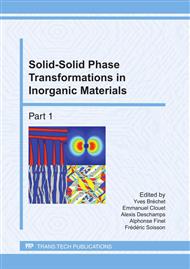p.161
p.166
p.172
p.178
p.184
p.190
p.196
p.202
p.208
The Use of Barkhausen Noise to Study the Martensitic Phase Transformation
Abstract:
The use of magnetic Barkhausen (MBN) noise methods to detect the austenite to martensite phase transformation during cooling of steel specimens was explored, using three different configurations: conventional Barkhausen noise emission stimulated by an alternating magnetic field, the Okamura method, that measures magnetic noise emission under a fixed DC field and a novel experimental technique that measures spontaneous magnetic emission during transformation, in the absence of any external field. The phenomena associated with the phase transformation were also followed by electrical resistivity measurements and the resulting samples were characterized using optical and scanning electron microscopy. MBN measurements on a AISI D2 tool steel austenitized at 1473K and cooled to liquid nitrogen temperature exhibited a clear change near 225 K during cooling, corresponding to the Ms (martensite start ) temperature, as confirmed by resistivity measurements. Spontaneous magnetic noise emission measurements made in situ during cooling of a sample immerged in liquid nitrogen showed that individual “burst” phenomena could be detected, in a manner similar to acoustic emission (AE) measurements. This magnetic emission (ME) can thus be considered a new experimental tool for the study of martensite transformations in ferrous alloys.
Info:
Periodical:
Pages:
184-189
Citation:
Online since:
June 2011
Price:
Сopyright:
© 2011 Trans Tech Publications Ltd. All Rights Reserved
Share:
Citation:


